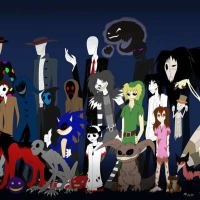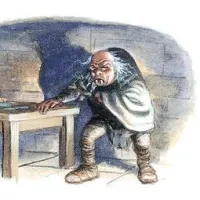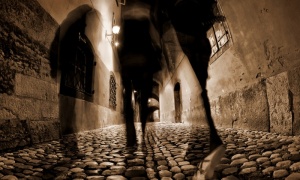Matt Ruff’s novel, Lovecraft Country, is set in Jim Crow America, long after Lovecraft’s death in 1937. Despite drawing the title from a term coined by Keith Herber to describe the fictional New England landscape in which Lovecraft set many of his stories, Ruff’s novel takes place primarily in Chicago; though there are excursions afield to locales both terrestrial and celestial, very little of the story is actually set in the eponymous Lovecraft Country. Nor do Ruff’s characters resemble the typical Lovecraftian protagonist — white, male, and with antiquarian tendencies. Atticus Turner, a 22-year-old African American Korean War vet, has just returned to his hometown of Chicago only to find his father, Montrose, has gone missing under mysterious circumstances. Montrose and Atticus never got along very well, mostly due to the friction caused by how each man navigated the racial tightrope of living in Jim Crow America. Guided by his Uncle George’s self-published ‘The Safe Negro Travel Guide’, Atticus, George, and Letitia, his friend from childhood, set off for the east coast to track down Montrose. Their trip takes them to a rustic white enclave in the backwoods of Massachusetts run by the wealthy Braithwaite family. The chaos that ensues from Atticus’ subsequent choices ensnares two black families and their friends into a centuries-long battle of freedom and oppression, hope and hatred, racial intolerance and violent magic.
Imagine that you’re driving home, and a police officer pulls you over for no reason. He begins to search your car and finds a stash of rare science fiction books, including an Edgar Rice Burroughs first edition, gift wrapped for your uncle. The officer proceeds to mess up these books, while laughing at the title of A Princess of Mars. That incident happens pretty early in Lovecraft Country by Matt Ruff, to African American hero Atticus Turner, and it’s one of the least upsetting incidents of racism—from the police, and from countless others—you’ll encounter in this book, which takes place during Jim Crow and conveys a gut wrenching sense of what it’s like to live in an openly racist nation. It’s a relatively minor thing, just having some old classic pulp novels screwed up, but to the audience of science fiction nerds who are likely to be reading Lovecraft Country, it’s a visceral moment of creepiness and violation. (And it comes right after Atticus and another black man have spent a couple pages bonding over their love for Ray Bradbury.) Ruff exposes his black hero to one of the worst indignities that most nerds could imagine undergoing—and then proceeds to show us, little by little, how much worse it could be, if you were a black man in 1950s America. The book thoroughly and effectively marries race and horror. It is a tense thriller, a terrifying nightmare, a heartbreaking tragedy, and a tale of holding onto aspiration and optimism even while being chased through the woods by a hell-beast from another dimension. The horror isn’t really the inter-dimensional demons, however, but the two-faced monsters wilfully tormenting an entire race for no other reason than they can.
Lovecraft has jokingly been referred to as “the most famous author you’ve never heard of.” Despite his relative lack of visibility — he’s not read in classrooms, nor will you find any of his books on a bestseller shelf — Lovecraft’s works of horror and science fiction in the early decades of the 20th century have had an outsized influence on popular culture. Everything from films like Alien and Pirates of the Caribbean to the music of Metallica and Black Sabbath to writers ranging from Borges to Burroughs have a bit of the existential terror that permeates Lovecraft’s fiction. Less highly regarded are Lovecraft’s ideas regarding race; a vehement believer in the superiority of white individuals over others, many of his stories were rooted in a fear of immigrants, miscegenation, and mixed ancestry. This mixed legacy has tarnished Lovecraft’s reputation. Even as recently as November 2015, the administrators of the World Fantasy Award announced that they would no longer be using Lovecraft’s likeness on their award trophies, a bust of whom has been granted to winners for almost 40 years. This was the culmination of a debate that had been raging for most of this decade about how to, and if it was even possible to, separate Lovecraft from his racism. If nothing else, any appreciation of the author must be qualified with a condemnation of his racism.
It’s worth noting at this point that while the book is titled Lovecraft Country, it is not Matt Ruff’s intention to dissect the author’s xenophobia or reimagine his fiction through a racial lens. It’s also not a commentary on how sometimes the things we love stem from “problematic” sources. In fact, the novel’s title is a distraction, one that diverts attention from Ruff’s true aim, which is to celebrate the early years of fantastic fiction. Lovecraft aside, Ruff draws inspiration from Robert Louis Stevenson, EC Comics and Abraham Merritt (the author of the first killer doll story, Burn, Witch, Burn). The book references Edgar Rice Burroughs while also name-dropping Bradbury, Asimov, and Heinlein. And as if that’s not enough, Lovecraft’s Country’s mosaic structure—a suite of closely linked novellas and novelettes—mirrors the old time fix-up, novels pieced together from an author’s shorter fiction published in the pulp magazines. It’s a book that wears its passion for genre on its sleeve. But what makes me smile—and this is a novel that often made me smile—is that while the book might have some of the same qualities of a fix-up, it avoids the pitfalls—those clunky bridges between two stories that were never meant to follow each other. And while Ruff’s narrative might draw heavily on the classics he provides a brilliant twist that more often than not highlights the second—and most important—aim of Lovecraft Country, detailing and critiquing the racial prejudice of the mid-twentieth century.
The book is beautifully structured as a short story collection and novel at one and the same time. In the overture, set in 1954, we meet Atticus, a veteran of the Korean war, who learns that his estranged father has disappeared in Massachusetts, trying to find out a family secret. Along with his uncle, the publisher of ‘The Safe Negro Travel Guide’, and his predictably feisty friend Letitia, he sets off on a rescue mission that involves secret societies, portals through reality and everyday bigotry. The first story takes up a quarter of the book, then subsequent chapters focus on individual characters and feature a haunted house, a pocket universe, a malign mannequin and a cursed book. It is established at the outset that Atticus is a fan of Lovecraft and other pulp fiction writers, and that his father is alert to the rancid racist undertones of such work. Because the characters know the script they can subvert it. It all leads to a very satisfying finale. This must be one of the kindest works in the horror genre I have read. Although the stories have genuine moments of horror, what shines through is solidarity, conscience and not backing down in the face of wickedness. There are plenty of nods to readers who know their Lovecraft – one story is entitled Dreams of the Which House – but these are optional extras. During a story within a story (a typical Lovecraft device) one character says: “He had this look on his face. Horror. Horror at the universe.” What’s so affecting is that it has more to do with the Klan than Cthulhu.


















Leave a comment